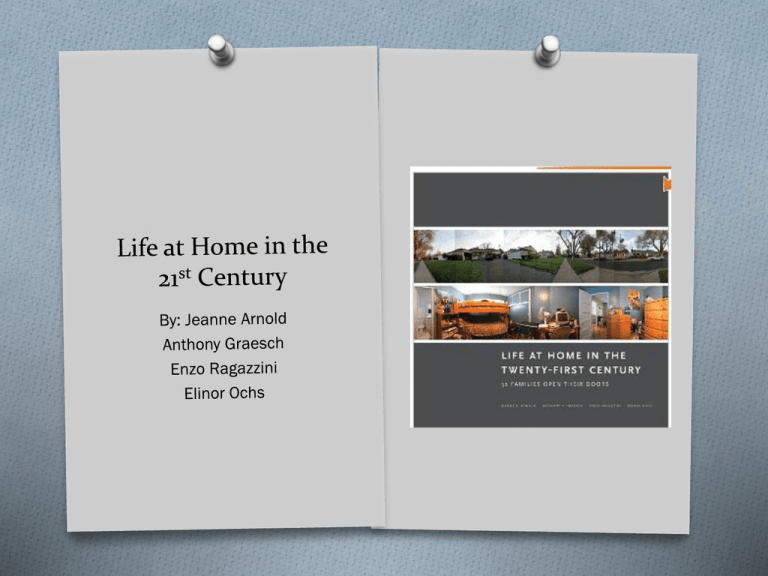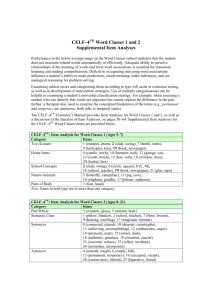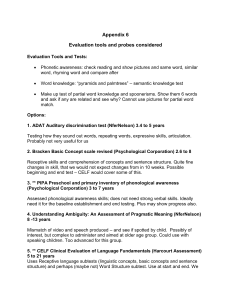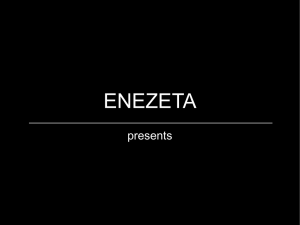Life at Home in the 21st Century
advertisement

Life at Home in the 21st Century “The houses we live in and the domestic objects we own-large, small, costly, inexpensive—define who we are and reveal much about our social identities, family histories, aesthetic preferences, behavioral patterns, affiliations, and economic standings.” (p.3) The Refrigerator Door The sheer volume of objects clinging to it may indicate how much clutter can be found throughout your home. Furthermore, that clutter provides a strong clue to how much stress Mom feels when she walks through the door at the end of a day at work. O What did your refrigerator door say? About the Study O 4 Year Study (2001 – 2005) O Documenting the life at home of 32 dual- income families in the LA area O All participants – O Have school age children O Identify as middle class O Are homeowners Research Design O Mapping O Intensive Photography O House History Questionnaires O Self-Narrated Home Video Tours Research Focus How possessions concentrated in specific house spaces function as organizational or mnemonic devices. 2. Which household artifacts families use most frequently to construct and express personal and family identify 3. Where the household artifacts are displayed 4. How remodeling choices and family investments in parts of the home tie in with cultural ideals. 1. “This volume is…an unflinching examination of actual homes amid all of the joys and messiness of real life. The photographs usher us into the intimate spaces of homes replete with each family’s unique selection of possessions and design choices. We see their unembellished material worlds.” - p. 11 Study Findings O Managing the volume of possessions was such a crushing problem in many homes that it actually elevated levels of stress hormones for mothers. O Only 25 percent of garages could be used to store cars because they were so packed with stuff. O The rise of big-box stores such as Costco and Sam's Club has increased the tendency to stockpile food and cleaning supplies, making clutter that much harder to contain. O The addition of costly "master suites" for parents proved the most common renovation in the homes that were studied, yet the spaces were hardly used. Study Findings Consistent and troublesome bottlenecks emerged in the homes, yet families rarely devoted renovation dollars to remedying these obvious problems. O Even in a region with clement year-round weather, the families hardly used their yards, and this was the case even among those who had invested in outdoor improvements and furnishings. O Most of the families relied heavily on convenience foods like frozen meals and par-baked bread, yet they saved an average of only 10 to 12 minutes per meal in doing so. O Fragmented dinners — those in which family members eat sequentially or in different rooms — threaten to undermine a sacrosanct American tradition: the family dinner. O - From: Sullivan, Meg (2012, June 19). Trouble in paradise: UCLA book enumerates challenges faced by middle-class L.A. families, UCLA Newsroom. Retrieved from http://newsroom.ucla.edu/portal/ucla/trouble-inparadise-new-ucla-book.aspx Seven Common Challenges Facing Middle-Class Families at Home Sullivan, Meg. (2012, July 19). UCLA Newsroom. Retrieved from: http://newsroom.ucla.edu/portal/ucla/celf-seven-common-challenges.aspx Mountains of Clutter (Photo credit: J. Arnold and CELF) O Managing the volume of possessions proved to be a crushing problem for the Los Angeles families. One family was reduced to collecting dirty laundry in an unused shower. O Mothers who lamented messy or cluttered rooms or unfinished remodeling projects when describing their homes were more likely to have elevated levels of stress hormones. O "Fathers would walk into the same rooms and make no mention whatsoever of the messiness. They were unaffected physiologically," said Jeanne Arnold, lead author of "Life at Home in the Twenty-First Century" and a UCLA archaeologist. "The differences between parents in their comfort level about clutter and its long-term impacts on well-being are pretty astonishing." The New Junk Drawer (Photo credit: J. Arnold and CELF) O Only 25 percent of garages could be used to store cars because they were so packed with household overflow. Family members said they were parking their stuff while deciding what to do with it. Plans to recoup the cost of unused items by selling them on eBay or Craigslist or at a garage sale rarely materialized. O "I don't think Americans intend to collect so much," said co-author Anthony Graesch, an assistant professor of anthropology at Connecticut College. "But we're really bad at ridding our homes of old possessions before buying new stuff." The Lure of Buying in Bulk (Photo credit: J. Arnold and CELF) O The rise of big-box stores has fueled a tendency to stockpile, which compounds clutter. The trend is so pervasive that close to half of the families kept a second refrigerator or freezer to accommodate all the extra food. Some even had a third refrigerator. With bulk-buying, even cleaning products can contribute to the crush of clutter, CELF researchers found. "We wish parents standing in line at Costco or elsewhere could project the future of a purchase once it arrives home and becomes part of the sea of clutter that demands seemingly endless housework," said co-author and CELF director Elinor Ochs. The Temptation of Toys O (Photo credit: J. Arnold and CELF) O Only 3.1 percent of the world's children live in the United States, but U.S. families buy more than 40 percent of the toys consumed globally. The Los Angeles homes were no exception. O Several homes had at least 250 toys on display, and most had at least 100. Untold numbers of other toys were tucked away in closets and under beds. O CELF researchers estimate that each new child in a household leads to a 30 percent increase in a family's possessions during the preschool years alone. Fragmented Dinner Time (Photo credit: J. Arnold and CELF) O Allowing dinner time to devolve into independent, individual mini-meals is threatening a sacrosanct American tradition: the family dinner. Fragmented dinners, in which family members eat sequentially or in different rooms, were commonplace in two-thirds of the Los Angeles households. O Just 17 percent of dinners were consumed with everyone together. Call of the Couch O Nearly three-fourths of the Los Angeles parents and about half of the children spent no leisure time in their backyards over the course of the study. They could not manage to carve out time to relax, play, eat, read or swim outside, despite the presence of such pricey features as built-in pools, spas, dining sets and lounges. Watching television inside proved the most frequent leisure activity for parents, consuming about 50 percent of their already limited leisure time, followed by reading magazines, newspapers and books (21 percent). O "Families are overscheduled yet very sedentary at home. The ideal of indoor– outdoor living — the California dream since the 1950s — seems increasingly out of reach," said co-author Jeanne Arnold, a UCLA archaeologist. (Photo credit: J. Arnold and CELF) Lure of the 'Refuge' (Photo credit: J. Arnold and CELF) O Upgrading the master bedroom — often with the addition of an adjoining bathroom — was the single most common remodeling project among the families. At the time of the study, the cost of expanding a master bedroom or constructing a suite of modest proportions was a little more than $80,000. The amount approached or exceeded the combined annual salaries for many of the families. O Often designed and decorated to evoke upscale hotels, these private spaces were envisioned as refuges from the hustle and bustle of family life. Yet, the suites were rarely used, except for sleeping, the researchers found. Meanwhile, vexing pinch-points in families' daily routines, such as crowded kitchens, were rarely fixed. Competitive Consumerism O American over-consumption can result in O Overwork O Overspending O Over-accumulating O Consequences of ‘manic’ consumerism O Bankruptcy O Massive Credit Debt O Physiological Stress O Sense of Failure (Cannot achieve the American Dream) The Amount Spent on Consumerism Average Annual Retail Sales in U.S. (Mid-2000s) $20.9 billion The amount received by the nation’s retailers for book sales $11.8 billion The retail value of 746 million music CDs sold $24 billion The cumulative amount paid by shoppers for toys, dolls, and board games $16 billion The cost to consumers for 1.2 billion DVDs and VHS tape $264.4 billion The amount consumers paid for 16.5 billion pieces of apparel $42 billion The price paid by shoppers for 2 billion pairs of shoes Food, Food, Food O Food marketing is the 2nd largest advertiser, primarily promoting processed foods O 10,000 new processed food products are introduced in the U.S. every year O Each day, 25% of adult Americans eat at a fast-food restaurant O Convenience foods, not so convenient. O Average family meal time preparation was 52 minutes. Families using primarily convenience foods save 5 minutes. Families Eating Together U.S. Families: Self-Reported 16% 34% 50% Always Usually Never LA Families: Filmed 23% 17% 60% Always Usually Never Plugged In O TV advertising expenditures are greater than O O O O O $50 billion 99% of US household own at least 1 television 50% own three or more Household spaces organized around the tv Between 2006 and 2009, 1.2 billion consumer electronic devices were sent to landfills (293 million units/year) Americans have thrown out 3 billion pounds of computer equipment in the last few decades Thoughts and Reflections?











